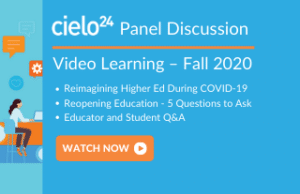The benefits and laws around Closed Captions. Closed captions are the visual display of the audio portion…

The Impact of Closed Captioning on Student Literacy
Do closed captions increase student literacy? The short answer is yes.
The connection between closed captioning and student literacy among children has been recently explored by educators and researchers. According to numerous research studies (for example Bowe & Kaufman, 2001; Evmenova, 2008; Linebarger, 2001; Rickelman, Henk, & Layton, 1991), it’s been shown that providing closed captions for educational materials – such as lectures and videos – has a positive impact on student’s reading speed, fluency, vocabulary, and overall comprehension. Closed captions have also been shown to simultaneously increase students’ enjoyment of reading. Sounds like a win-win!
The Different Ways Video Captions Impact Student Literacy
Increased Enjoyment of Captioned Videos
The studies have shown that students consistently prefer viewing captioned media over traditional print or uncaptioned videos. Even students who did not receive any educational benefits from the closed captions found them easier to understand and fun to watch. While captions cannot fully replace traditional reading, they can present information in a new, alternative way.
One by-product of these studies is the idea that, by increasing children’s enjoyment of the media they consume, students will be more likely to increase their literacy. Educators who utilize closed captions as a literacy tool will find their students more engaged with the learning process. This can be a game-changer for teachers and educators struggling to keep their students excited about reading.
Exceptional Tool for ESL and Disabled Students
Closed captions also serve as an incredible tool for teachers assisting students with learning disabilities or language barriers. Learning a new skill, such as reading, can be a difficult task for any child. Now, consider the increased challenges ESL students or students with learning disabilities face when trying to learn to read. These students often face intense anxiety and stress around their literacy skills when compared to their peers.
Because of their description of audio and scene, captioned videos can include more contextual information and lower barriers to entry than traditional text-heavy media, such as books or newspapers. This can help ESL or disabled students feel less overwhelmed or intimidated. Even if a student still struggles to comprehend the captions, combining captions with video audio helps to teach and reinforce unknown vocabulary. Closed captioning decreases the emotional and psychological stress associated with learning to read and allows students to feel confident in their growing literacy. This confidence in turn prevents them from falling academically behind their peers.
Improving Reading Speed and Comprehension
It has been argued that closed captions can be distracting or confusing for viewers. However, because of the intuitive nature of captions, students are actually more likely to understand the video content than text-heavy print media or uncaptioned videos.
One study conducted in Hawaii found that students who viewed karaoke-style closed captions with Broadway musicals, such as “Les Misérables” or “Cats”, had higher reading comprehension scores on follow-up tests than those who watched without captions.
Practice Makes Perfect
Learning to read takes practice and persistence. Often, children can become overwhelmed by too many unknown words, making it difficult to motivate them to keep trying. As with any new skill, the more time you spend practicing, the more you will improve. This holds for literacy. The more students can practice their literacy skills, the faster their reading speeds. By including closed captioning for all types of video media, such as YouTube videos, movies, or TV shows, students can practice their literacy skills both inside and outside the classroom.
Increased Vocabulary Acquisition
Closed captions provide immense benefits for literacy because it combines both auditory and visual learning styles to reinforce students’ familiarity with new words. Children learn new vocabulary words based on what is important to their daily lives. For this reason, closed captions can be increasingly important for content or subject-specific material.
For example, if the word “boat” comes up in an educational video but a student has never seen one before, understanding the word can be daunting or overwhelming. Closed captions provide students with both a visual of the word and auditory clues, making vocabulary acquisition easier.
From increasing students’ enjoyment of reading to improving their vocabularies, closed captions have immense educational benefits. Overall, closed captions provide parents, teachers, and students with the opportunity to turn every video or TV show into a learning experience. This ubiquitous approach to education has significant benefits for students and their literacy development.
How cielo24 Works with Learning Institutions to Improve Student Literacy Through Video Captions
 cielo24 proudly works with learning institutions across the globe to create a seamless and accessible digital learning experience. Our video captions and audio transcriptions also help to increase engagement, improve SEO, and increase conversions for your digital content.
cielo24 proudly works with learning institutions across the globe to create a seamless and accessible digital learning experience. Our video captions and audio transcriptions also help to increase engagement, improve SEO, and increase conversions for your digital content.
Begin captioning course video immediately at less than $1/minute. Contact us for a Free Enterprise trial based around your unique business needs. Or contact us online or call us at 1-855-243-5624.
You can also check out our new standard Audio Description solution, which helps schools meet compliance requirements and includes the audio track and visual description of what is happening in the video.



